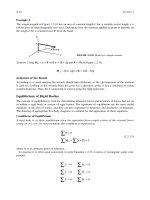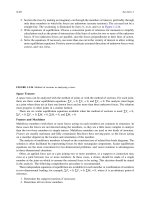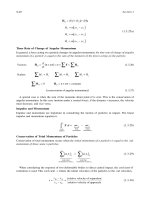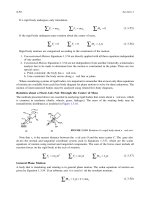CRC Press - Mechanical Engineering Handbook- Mechanics Of Solids Part 4 pdf
Bạn đang xem bản rút gọn của tài liệu. Xem và tải ngay bản đầy đủ của tài liệu tại đây (29.05 KB, 1 trang )
1-30 Section 1
(1.2.37)
where I or J
O
= moment of inertia of M or A about any line ᐉ
I
C
or J
C
= moment of inertia of M or A about a line through the mass center or centroid
and parallel to ᐉ
d = nearest distance between the parallel lines
Note that one of the two axes in each equation must be a centroidal axis.
Products of Inertia
The products of inertia for areas and masses and the corresponding parallel-axis formulas are defined
in similar patterns. Using notations in accordance with the preceding formulas, products of inertia are
(1.2.38)
Parallel-axis formulas are
(1.2.39)
Notes: The moment of inertia is always positive. The product of inertia may be positive, negative, or
zero; it is zero if x or y (or both) is an axis of symmetry of the area. Transformations of known moments
and product of inertia to axes that are inclined to the original set of axes are possible but not covered
here. These transformations are useful for determining the principal (maximum and minimum) moments
of inertia and the principal axes when the area or body has no symmetry. The principal moments of
inertia for objects of simple shape are available in many texts.
I I Md M
I I Ad A
J J Ad A
C
C
OC
=+
=+
=+
2
2
2
for a mass
for an area
for an area
I xydA xydM
I yzdA yzdM
I xzdA xzdM
xy
yz
xz
=
=
=
∫∫
∫∫
∫∫
for area, or for mass
or
or
II Add I Mdd
II Add I Mdd
II Add I Mdd
xy
xy
xy
xy
xy
yz
yz
yz
yz
yz
xz
xz
xz
xz
xz
=+ +
=+ +
=+ +
′′ ′′
′′ ′′
′′ ′′
for area, or for mass
or
or









